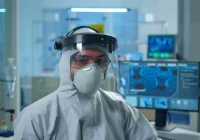Imaging is integral to intensive care, where frequent X-rays, fluoroscopy, CT and nuclear medicine guide day-to-day decisions for critically ill patients. Repeated examinations during prolonged admissions can drive cumulative effective dose to levels that warrant careful management, with CT the dominant contributor. Safe delivery relies on robust justification, disciplined optimisation and coordinated practice across hospital administration, clinicians, radiographers and radiologists. Tailored diagnostic reference levels for ICU contexts, dose monitoring, and advances such as low-dose and ultra-low-dose CT with modern reconstruction can curtail exposure while preserving diagnostic value.
Cumulative dose and risk
Published ICU cohorts show wide variation in cumulative effective dose, reflecting differences in pathology mix, length of stay and modality use. Reported ranges span from fractions of a millisievert to levels above 50 mSv during a single admission, with a small proportion exceeding 100 mSv. In ventilated trauma populations, cumulative dose increased over time in line with more CT scans per patient, underscoring modality mix as a key driver. Across mixed ICU series, CXRs are common yet contribute a small fraction of total dose, whereas CT accounts for the vast majority despite representing a minority of studies.
Risk estimation frameworks also vary. Models derived from the Life Span Study remain widely used, with the linear no-threshold model often adopted despite acknowledged limitations at low dose. Estimates of lifetime attributable risk tied to ICU imaging illustrate that average exposure can translate to a measurable, albeit modest, population-level cancer risk signal. The variability between risk models for comparable ICU exposure profiles highlights a need for more reproducible cancer risk modelling grounded in contemporary epidemiology rather than relying solely on historic cohorts.
Clinical and organisational factors align with higher cumulative dose. Trauma, sepsis, higher severity scores and extended ICU stays recur as correlates of increased exposure, reflecting both clinical complexity and the intensity of imaging required. Interventional radiology and fluoroscopy add to dose burdens where procedures are prolonged or repeated. These patterns reinforce the importance of justification at the point of request, protocol selection attuned to the clinical question, and continuous scrutiny of repeat imaging during a hospitalisation.
Governance and optimisation
Reducing exposure in the ICU is a shared responsibility. Hospital administrators influence outcomes through investment in contemporary equipment, appropriate space and workflow design that support safe imaging of critically ill patients. Clinicians carry primary responsibility for justification, submitting focused requests and limiting repetition across a patient’s stay, aligned with European basic safety standards. Radiologists and radiographers lead optimisation and dose limitation, while medical physicists assure quality control and equipment performance to keep doses as low as reasonably achievable without impairing diagnostic quality.
Diagnostic reference levels are a cornerstone of optimisation. Set at the 75th percentile of national practice distributions and expressed through metrics such as dose-area product for radiography and fluoroscopy and CTDIvol and dose-length product for CT, they serve as pragmatic yardsticks rather than patient-specific targets. Size-specific dose estimates further account for body habitus when interpreting CT dose indices. In ICU settings, where repetition is frequent, modifying reference levels to reflect realistic best practice for this population has been proposed to temper cumulative exposure. These proposals sit alongside the recognition that DRLs can be exceeded when clinical gravity demands it.
Must Read: A Global Review of Patient Safety Instruments
Dose monitoring systems now aggregate scanner-generated dose reports with demographic and protocol data to support Monte Carlo-based effective dose estimation, audit justification and track trends across modalities. Educational initiatives can raise awareness of dose among prescribers, yet evidence suggests that information alone may not shift ordering behaviour, indicating the need for combined administrative, clinical and technical levers. Pan-European initiatives in patient radiation protection emphasise justification, optimisation and dose limitation for both patients and staff, offering a framework that can be operationalised at ICU level.
Modality-specific strategies
Portable chest radiography is ubiquitous in intensive care. Routine daily imaging after an initial assessment may not improve outcomes and contributes avoidable exposure when used indiscriminately. Technique refinements help preserve quality at lower dose, including careful collimation, appropriate source-to-skin distance, judicious kV and mAs selection, and use of modern digital detectors. When clinically appropriate, ultrasound offers a radiation-free alternative with high diagnostic accuracy for common respiratory problems, and supports vascular access and procedure guidance at the bedside.
Fluoroscopy and interventional procedures can deliver substantial doses during complex or prolonged cases. Exposure can be moderated through attention to geometry, filtration, pulse rate, magnification and time under fluoroscopy, supported by automatic brightness control and effective detectors. Contemporary guidance defines procedural thresholds for doses that warrant particular vigilance, reinforcing the need for prospective planning and intra-procedural awareness in susceptible ICU patients.
CT remains the principal source of medical radiation in ICU care. Transport to scanners is often challenging for unstable patients, and image quality can suffer from lines, tubes and arm positioning. Portable head CT can mitigate transport risks where available. Justification practices vary across Europe, making systematic pre-scan review especially important in this population. When CT is required, sub-millisievert protocols for suitable indications, together with careful control of tube current, peak voltage, rotation time, collimation and automatic exposure control, can substantially reduce dose while preserving diagnostic content. Spectral shaping, improved bow-tie filters and restricted anatomic coverage further assist dose reduction.
Advanced image reconstruction has become a powerful adjunct to protocol optimisation. Iterative reconstruction reduces noise and artefacts compared with filtered back projection, enabling acceptable image quality at lower dose. Deep learning image reconstruction can deliver further noise suppression and signal-to-noise gains with shorter reconstruction times than some model-based techniques, supporting low-dose practice in ICU populations. Emerging detector technologies such as photon-counting CT promise additional dose efficiency and image quality benefits. In nuclear medicine, modality selection and isotope choice influence exposure, with preference for tracers whose half-life matches study duration and for pure gamma or positron emitters when clinically appropriate.
Intensive care demands frequent imaging, yet sustained attention to justification, dose tracking and technical optimisation can materially lower cumulative exposure without compromising care. The greatest leverage lies in CT practice, where tailored protocols, disciplined coverage and modern reconstruction algorithms combine to reduce dose. Setting ICU-specific reference levels, using dose monitoring and involving all professionals helps ensure safer imaging for patients during complex and prolonged admissions.
Source: British Journal of Radiology
Image Credit: iStock










